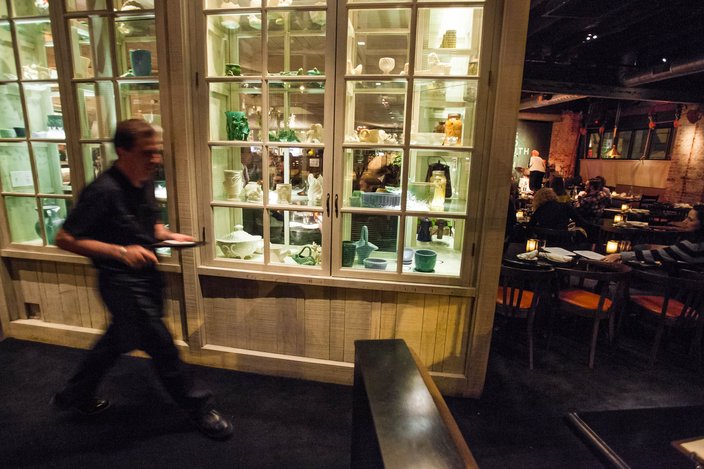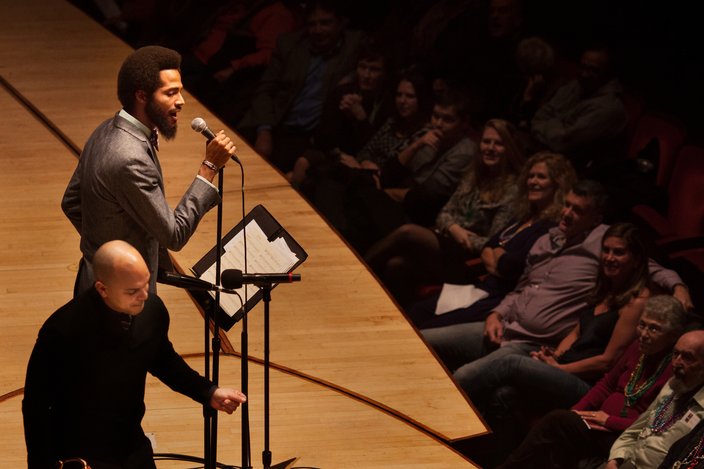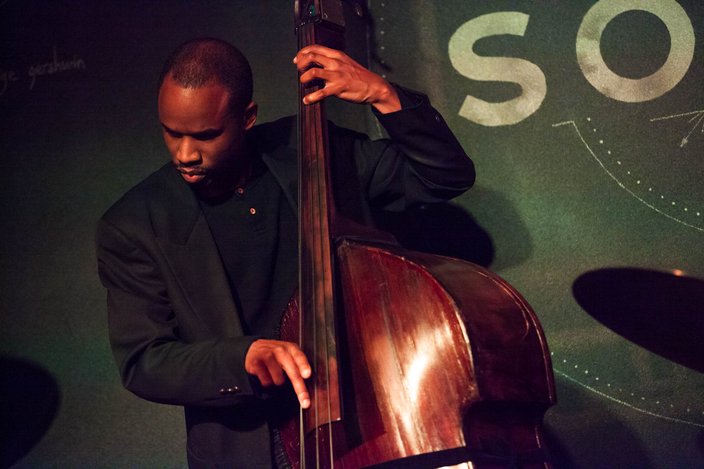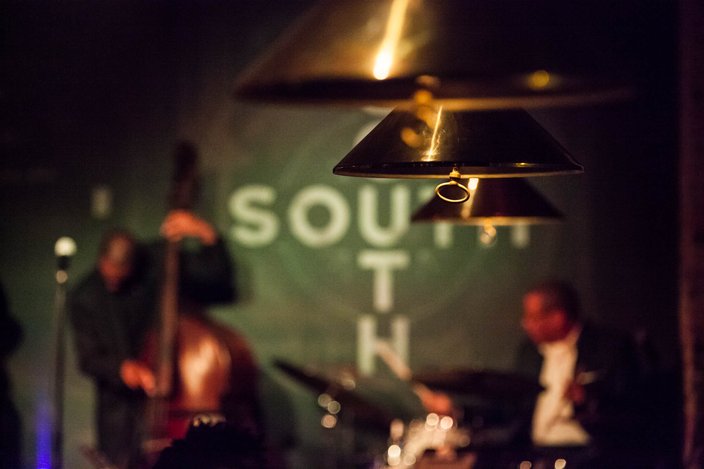
December 23, 2015
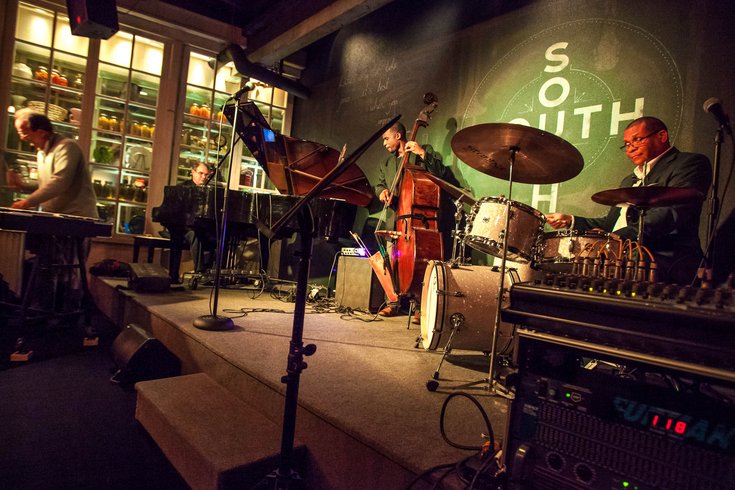 Thom Carroll/PhillyVoice
Thom Carroll/PhillyVoice
Drummer, Leon Jordan Sr., right, presents the Jazzy Jam Open Mic night at SOUTH Kitchen & Jazz Parlor, now open on North Broad Street.
It's 8 p.m. on a Wednesday in November, and the room starts to fill.
The sound of cheers and laughter emanate from a group of sophisticates in a corner booth, a 20-something couple on "date night" sip bourbon martinis at a table nearby and three performers, dressed in their Sunday best, file on stage as a fleet of hanging brass lights dim, blanketing the room in a warm glow.
Add smoke, Dizzy Gillespie and some scatting, and you'd think it was 1950 in Philadelphia, not 2015.
So goes the scene at SOUTH Kitchen & Jazz Parlor at 600 N. Broad St., which was quietly opened in October by brothers Robert and Benjamin Bynum as a hotspot for Southern cuisine and jazz. The parlor, separate from the dining area, seats 75 and feels, in presence, sophisticated without succumbing to pretentiousness. A jazz club in a very traditional sense, it features performances six nights a week (it's closed Mondays) and boasts talent local and national, young and old.
It is, Robert Bynum says outright, an attempt to bring attention back to jazz in Philadelphia, as well as to engage a younger, millennial jazz audience -- like capturing lightning in a bottle when it comes to the genre.
"There’s an awakening in that generation that sees things in a different perspective, and our hope is jazz music is also viewed that way," Robert Bynum told PhillyVoice, citing millennials' interest in premium food and craft cocktails. "And I think when people see that jazz is not just Miles Davis from 50 years ago, they do have an interest in it."
It's not just Bynum's club that's looking to give jazz another turn in the spotlight, either. Nay, it's one of many efforts in Philadelphia right now out to prove that jazz in the city has never gone away or "died." Like so many other cultural works left behind by urban decay, it's just been patiently waiting for the pendulum to swing back.
And with new pushes from the city, schools and young talent itching to test their tubas, jazz may finally be inching its way back to center stage in Philadelphia.
Though it's difficult to put a finger on exactly what's triggering renewed interest in jazz, it's no secret that the fresh sounds of the city's youth are sparking intrigue.
Take 18-year-old University of the Arts student Isaiah Moregrass, for example. He grew up listening to jazz through his family, but because of his gospel upbringing in Kingsessing and the neo-soul influence of his peers, he's not just sticking to the standards. He is, he said, choosing to tell his story, rather than strictly those of the Philly-bred legends who preceded him.
"My friends and I will listen to John Coltrane and the greats, but we also like to gain influence from newer guys -- not just jazz, but the kind of cats like Terrence Blanchard and Robert Glasper, the kind who fuse together neo-soul, hip-hop, gospel and jazz," Moregrass told PhillyVoice. "If we're just playing the same old jazz, we're not telling our story."
And that young sound, he said, tends to beget a young audience when he and his cohorts perform in Philadelphia. Because while mid-20th-century jazz staples -- like Billie Holiday, Nina Simone, Charlie Parker and John Coltrane, to name a few -- are essential to the lifeblood of jazz in the city, they've also been a barrier to progress.
"We love the greats," Moregrass added. "But we look forward to progressing jazz and moving it to something a little more unique."
Established artists are taking notice, too.
"Right now I hear original composition and more fresh-sounding jazz overall, and that’s pushing jazz in a different direction than predecessors and older guys in the area," Laurin Talese, a 33-year-old, Mt. Airy-based jazz vocalist, told PhillyVoice. "The difference you’ll hear is church influences, rock influences -- they may be covering Radiohead, who knows. But the covers being chosen and the approach is way fresher, and there’s an audacity and fearlessness there due in part to the fact that this generation kinda doesn’t care about labels and aren't afraid to add their experience to the tradition."
That emerging fearlessness is actually in spite of a culture that has, in recent years, churned out new performers as if by assembly line.
Talise: Covers being chosen and the approach is way fresher. There’s an audacity and fearlessness [among millennials] due in part to the fact that this generation kinda doesn’t care about labels and aren't afraid to add their experience to the tradition.
Frank Machos, director of the School District of Philadelphia's music program, told PhillyVoice that since the 1990s, jazz has become much more "institutionalized" than it's ever been, which may partly be why jazz is moving back to center stage at a crawl's pace instead of a full-on strut.
While jazz programs produce performers, establish networks, teach fundamentals and prime new audiences, there are, Machos said, drawbacks to a model where kids learn to replicate sounds in the classroom. By way of there being fewer jazz venues than in decades' past, it's not necessarily as often that students take their skills to smoky rooms and organically riff with mentors inside of, say, what was formerly Ortlieb's Jazzhaus.
The result: technical proficiency, but reluctance to innovate.
"When educators are like, ‘This is jazz and this is hip-hop,’ kids are confused," he said. "But when you just do your thing and put it all together, you get this amazingly natural sound coming out of them."
Since taking over the music program in 2013, Machos has massaged that sound by encouraging teachers to let students test the waters. Despite working with a music budget reduced from more than $1 million to $50,000, he has leveraged partnerships with the Kimmel Center and the Philly Pops to develop what was a declining annual jazz concert into a forward-thinking after-school program.
The Kimmel Center also now requires high-profile performers like Venissa Santi of its Jazz Residency Program to work with area artists -- including those youngsters from the district -- as collaborators and mentors. Jay Wahl, artistic director for Kimmel Center, told PhillyVoice he took the development of jazz at the center "very seriously" when he took over in 2012, with the goal of making Kimmel the "center for jazz in Philadelphia" and a place that develops audiences as much as artists.
So, all of that in mind, what's the holdup with getting the music heard? Quite simply, a lack of recognition that new jazz music is even out there. Take a gander at a Q102 playlist, after all, and the closest you'll find to a jazz influencer is Adele.
When radio is no friend of jazz, the city and its cultural institutions need to be.
The proposed solution for fast-tracking the genre back into the spotlight is twofold: promoting jazz through events, as well as offering more performance spaces -- yes, like SOUTH and the Kimmel Center, but also in more nontraditional venues.
"Right now we’re going through what I think is a renaissance," Thomas Camarda told PhillyVoice of the city's jazz scene.
Camarda is the straight-shooting co-founder of Jazz It Up Philly. As a man stepping on the scene in 2009, he was taken aback by how few devoted jazz spaces were left in Philadelphia, considering more than 30 once stocked Broad Street, North Philadelphia, 52nd Street and other areas of the city during jazz's peak between the 1940s and '60s, driven by an influx of black populations.
"The problem is not the creation of these performers and musicians, it’s that they have no place to go ..." Camarda said. "There’s this influx of talent coming in and no place to carry them. And what choices does that give them?"
In the spirit of the city's history with jazz, Camarda, alongside partner Charlie Bartlett, launched a program last November that pairs performers with restaurants, meant to bring jazz back to the days when you could find it anywhere. Last year, Jazz It Up Philly aimed to create four shows for all of 2015; instead, they ended their first year with 24 sell-out shows at restaurants like Volver, Prime Rib and Union Trust.
Thinking even further outside the box, Camarda has also collaborated with Machos to give young performers in the All-City Jazz Festival deals to record 10-song CDs and market 300 copies of them, for free. It's an effort to get their music heard by the masses, but also teach up-and-comers how to promote themselves.
"The kids of today won’t be kids in 10 years; they’ll be our future," Camarda said. "Just going to school for music and learning to perform, and be on stage, and play guitar, or how to do sound boards, stuff like that, that’s not good enough. You need business knowledge."
The city, meanwhile, has contributed by ushering in opportunities for jazz artists to promote their work.
"The more you promote jazz, the more demand you create," Chief Cultural Officer Helen Haynes told PhillyVoice.
She explained that, because jazz in Philadelphia has evolved from "club to concert hall" and other mixed venues, we must rethink the conventions of jazz as a club music and promote the genre as one that can be heard anywhere. It opens the door for performers to get paid in more venues and opens the ears of general audiences to what contemporary jazz actually sounds like.
The city's biggest effort to help the movement along was to declare April "Jazz Appreciation Month," which last year hosted 40 events from 20 institutions in the city. It's also welcomed countless jazz festivals and the 2013 Jazz Connect Conference and, Mayor Michael Nutter told PhillyVoice, is in the process of planning a major city-sponsored festival for 2017.
"Quite frankly, it's unusual that, given our history and level of engagement with this music form, we don’t have a well-sponsored, well-run, week-long jazz festival here in this city," Nutter said. "I think we have to talk about having more venues and paying attention to music -- those are all parts of the solution, and marketing [jazz] and literally driving people to it."
In other words: Perform, and they will come.
Inside Time on a Sunday night, the air swells with the combined sounds of a cello, drum and keyboard. Together they summon the melody of "It's the Most Wonderful Time of the Year," the players looking at each other with intensifying excitement. The keyboard builds and builds into a solo until, like a crash, the bottom drops out. A nearby 20-something, bopping and bouncing in her seat all the while, scrunches her face with a look of climax -- an expression of Yes, that's the spot.
Then she sips from a glass of red wine and lets the music drift her away.
"If you were to point any naysayers who say you don’t see young people hearing jazz anymore, I always point them to Time," Terell Stafford, director of jazz studies at Temple University and Jazz Orchestra of Philadelphia, told PhillyVoice.
And on this particular December evening, it's certainly true: the room fills out by 9 p.m. with a crowd of about 30, at least half of them younger than 30 -- some of them fellow jazz musicians there to support and network, others there with friends.
But more importantly, there's a feeling in the air that no one's simply happened upon jazz while there for dinner or a drink; they came to listen. And that alone is significant for the genre's future in Philly.
Philadelphia's jazz scene has never floundered for a lack of demand or talent, but especially not the latter. Pianist Tim Brey, saxophonists Elijah Thomas and Isaiah Moregrass, and swing-jazz vocalist Chelsea Reed are all go-getting young performers determined to show audiences the emotional truths that come with jazz, provided they can find a place to play.
Because jazz isn't just about sounds; it's about mood and spontaneity.
Jazz, you see, is often described as conversation. Not just one between performer and audience, but between jazz performers themselves. They riff, they jibe, and what comes out is something new and authentic every time. For that reason, it's important for jazz, perhaps more so than many other music genres, to be heard in a live setting.
And why the endurance of jazz -- and its newfound momentum -- matters at all in Philadelphia goes beyond the obvious selling line that it's drenched in history. Philadelphians are complicated creatures: they hurt, they groan, they fight, they feel. And with a city so complex, why shouldn't its music be, too?
Know this: the pendulum is swinging back for jazz in Philly, but how quickly it does so will be entirely dependent on how willing Philadelphians unfamiliar with the genre are to step out of their comfort zones and squat into the seats of clubs, restaurants or concert halls all around town.
"Philly is definitely a town of ‘I know, I’ve seen it, I love it.’ But how about if you don’t know? How about if you haven’t seen it? And how about if you don’t know if you love it?" Orrin Evans, who curates Wednesday night programming at SOUTH, told PhillyVoice.
"What people need to know is to let go of what they know in order to find out what they didn’t know.
"People need to know that they don’t know."
